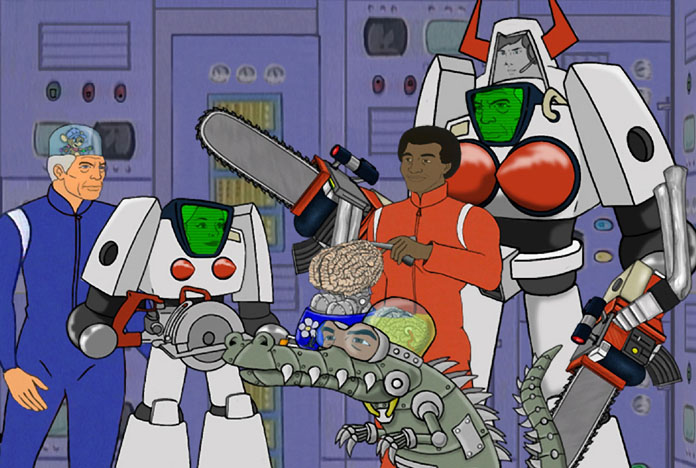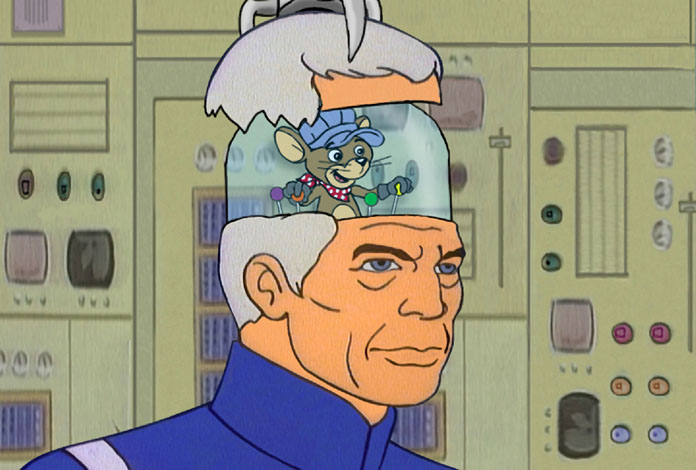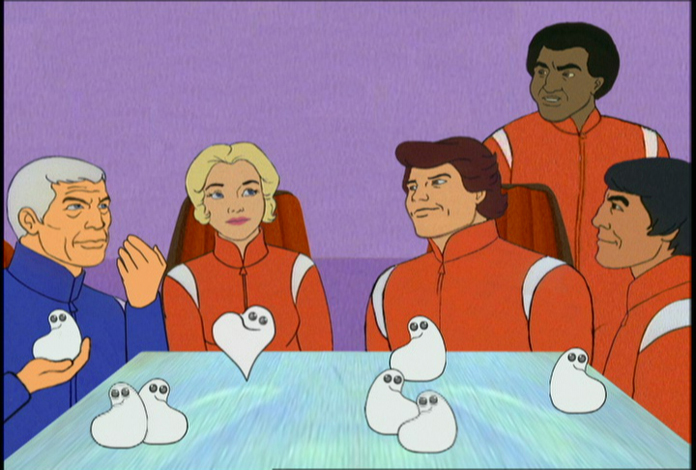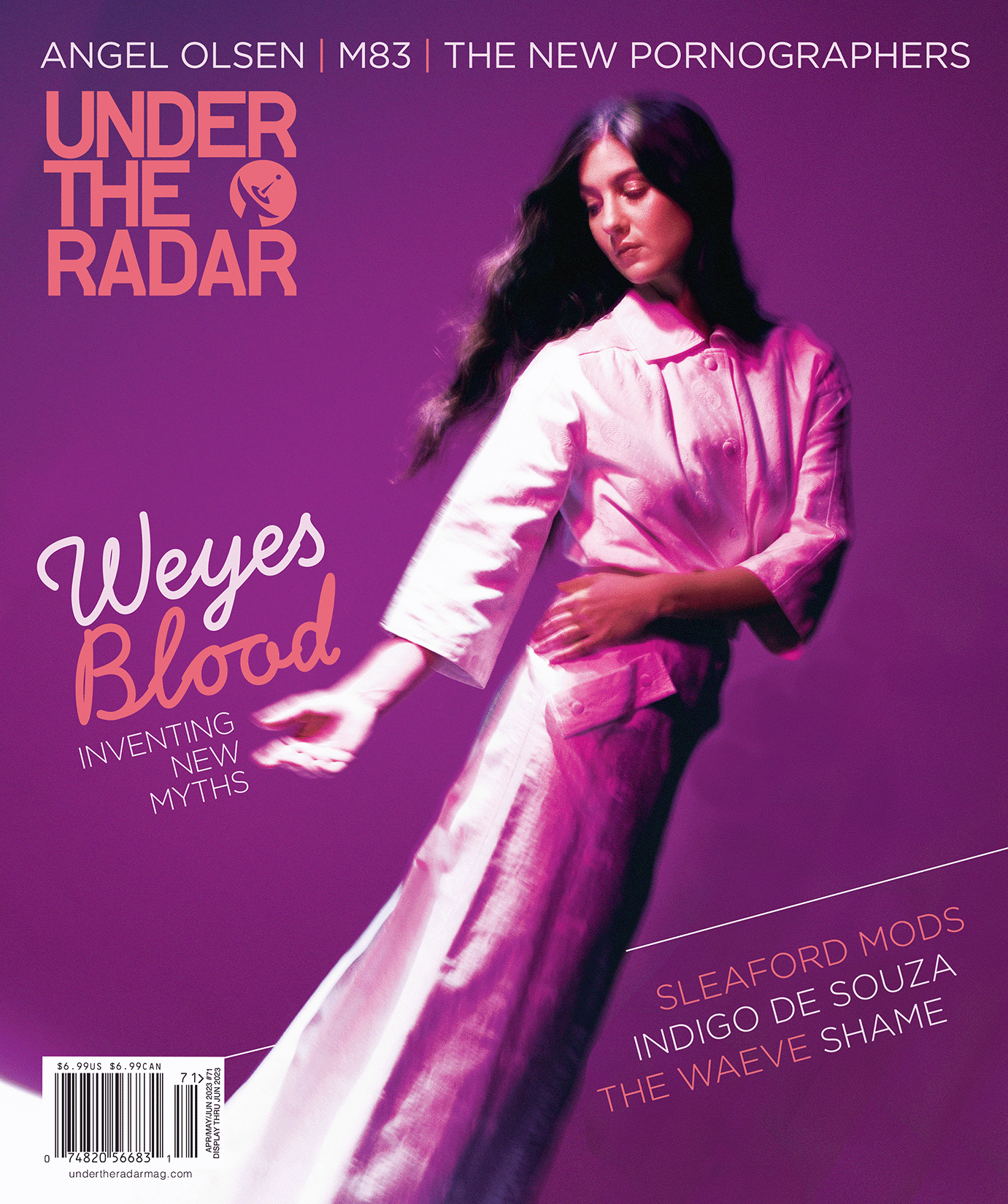
Matt Thompson on the Origins of Adult Swim’s “Sealab 2021”
Underwater Antics
Dec 15, 2020
Matt Thompson
![]()
Sealab 2021, one of the four original Adult Swim shows that aired first in December 2000 and then later, more formally, in September 2001, was the underwater-set work comedy in which a group of scientists living in a submarine laboratory interact and get into trouble. The show, created by Matt Thompson and Adam Reed, made use of older Hanna-Barbera cartoon footage from a former cartoon, Sealab 2020, made originally to highlight ocean conservation. But reused and put through the surreal Adult Swim lens, the 2021 version sung with madness and warm, fuzzy oddities. We caught up with Thompson, the show’s co-creator (thanks to the fine folks at HBO Max), to talk about how he first fell in love with animation, how Sealab 2021 found Adult Swim (and the Cartoon Network) and what he remembers most from making the show.
This is the second in a running series on Under the Radar celebrating Adult Swim and the airing of its first original block of cartoons: Aqua Teen Hunger Force, Sealab 2021, The Brak Show, and Harvey Birdman, Attorney At Law. Watch Adult Swim on HBO Max.
Jake Uitti (Under the Radar): When did you first find animation and fall in love with it?
Matt Thompson: I was all Marvel all the time. I was all Marvel comic books, all Marvel everything. I would trade off between a Captain America shirt, a Hulk shirt. And I grew up reading the original X-Men run and also tthe Fantastic Four, which is just so criminal right now that people don’t know the Fantastic Four is awesome. All kids think Fantastic Four sucks and it’s, like, no! Fantastic Four is amazing! So, I had a heart in it just from there. And I continued to read comic books as I was getting going but then I kind of walked backwards into my first job, which was a P.A. at Cartoon Network in the on-air promotion department.
When I graduated from college, it was one of those periods of time where it was absolutely impossible to get a job. The economy, like, nobody could get a job. And I was just hustling everything I could do to get a job in TV and that was one I was able to secure. That led me to figure out what a unique opportunity there isare with cartoons in general to control the entirety of the narrative. What it becomes is a great way to always be able to control of what’s failing and to know it’s not that big of a deal. You don’t have to worry about reshoots. It’s not live action, you can keep control of your narrative if you keep your crew together and keep working the problem and making it better.
It’s really a fantastic story medium from that standpoint. A cartoonist is just never done with their cartoon, they just run out of time. You can always make a sequence visually better, you can make a joke better as long as you have the time and money. That’s what I found out working as a P.A. at Cartoon Network. You can take these things, fart around and kick something out in a couple days and revise it. And then revise it. And then revise it. That was empowering to figure out that side of storytelling.
That’s interesting that learning about the editorial process after the fact was a big moment for you and that you discovered that at Cartoon Network.
Yes, very much so. It also was in the early, early days of Cartoon Network. It was the second year that it had been a network. And Adam [Reed], I think, came to Cartoon Network in the third year. So, it was kind of a little bit like the Wild West where all the people that were there were kind of getting to do a bunch of shit that you don’t usually get to do when you’re 25-years-old. It’s kind of like how MTV was in the 2000s in New York. As long as you’re willing to take very little money, you’re allowed to be in charge of things that you shouldn’t be in charge of.
I’m envious of finding those Wild West moments where all the tools are available but no one has stamped their name on them quite yet.
There’s a whole host of people from the original lineup of Adult Swim and we’re all still pretty decent friends. I’m very close with David Willis, who’s still in Atlanta, still making cartoons. Dave and I work together from time to time. But there’s, like, a small crew of the original show people who will have a beer every once in a while.

When I first found Adult Swim, it had this big impact because I think I noticed or felt that all-in-it-together energy at the time. I think that’s what resonated with me even though I didn’t totally know it.
From early on, [Adult Swim creator] Mike Lazzo always considered that place a pirate ship. We were the pirates. And it created this rebellious, outlaw streak in all of the people that were making shows for him. Like, we didn’t think that any rules applied to us as long as Mike didn’t tell us different. And Mike didn’t give a shit about no rules.
He also created Space Ghost Coast to Coast, which feels like the godfather of your show, and the other original shows on Adult Swim. What was it like for you when you first encountered Space Ghost for the first time?
I loved it. I couldn’t get enough of it. I’m also really good friends with Matt Harrigan, who’s been off and on with Adult Swim throughout the years, but he was heavy on it in the early stages. Harrigan now runs streaming for Adult Swim and, so, Harrigan was there and both Maiellaro and Willis were there. And, you know, Adam and I didn’t ever work on Space Ghost but we were very Space Ghost adjacent. We’d sit there and just watch what those guys were doing and have a blast.
It’s funny. When I first came to Adult Swim, Space Ghost was the one show I didn’t get. It just ricocheted off me. Now, going back to it, I can’t get enough of it. I watch it every night. But it’s gone through its own set of ups and downs.
Yup, David Willis and I have talked about this before. Something similar happened to both of us. On Sealab, my first Adult Swim show, our lead character [Harry Goz, voice of Captain Murphy] died in the middle of the series run. So, we faced the choice of, like, do we replace him as an actor and keep the character? Or do we lose the character? And he was our lead character. We made the choice that Adult Swim supported to kill the character and move the character on. Because we just couldn’t bring ourselves to voicing that guy again. It changed the show fundamentally when you take out your lead character. And David Willis was in charge of Space Ghost when Clay Croker [voice of Zorak and Moltar] passed. That was, like, for him, he was like, “I don’t want to make any more Space Ghost.” From my understanding of how it went, anyway. We kind of felt the same way about Sealab.
When did Harry Goz pass, was that in the middle of the second season?
Yup. So, there’s an episode in the second season that just makes me smile thinking about it. There’s an episode that, for no fucking reason, Captain Murphy is wearing an old-timey diving bell. Like somebody in the ’30s would try and get on the bottom of the ocean with. But he’s wearing it just on the top of his head. And it’s on his head because we had to put a filter on Goz’s voice. Because his voice was so weak because the cancer had progressed throughout his body. He was extremely weak but he really wanted to do that last episode. He’s like, “Nope! I’m doing it!” So, his wife had to take him down to the studio, help him into a chair, get him into a chair, record that episode. And, like I said, his voice was so weak, we had to put a filter on it so you didn’t think that something was too crazy. He died shortly thereafter that. The guy wanted to do the job—amazing.
Do you know the history behind Adult Swim using Hanna-Barbera cartoon footage? How that happened for Space Ghost and then for Sealab 2021?
Well, that was one of the first libraries that Ted bought, you know? From my understanding at the time, it was that Ted Turner bought the Hanna-Barbera library and then used that to make Cartoon Network, proper. So, he buys it in, like, ’93, and then Cartoon Network is on the air the year later, re-running as much Hanna-Barbera as they can all day. But what that meant was the people like me and Adam and David Willis and Maiellaro and all these guys were standing around looking at all this footage and knowing that Adult Swim wanted to put things on TV that cost $5 and the only way to do that was different versions of What’s Up, Tiger Lily, the old Woody Allen movie. But we took it to the extreme on Sealab where we did a whole sit-com.
On Space Ghost, they had kind of solved the problem the same way. They just cut a bunch of different Space Ghosts out of the cartoon and they put it on a set. In the early years of both Sealab and Space Ghost, there were very few original drawings. It was all done through rotoscoping and then manipulating the rotoscope. So, it was just cutting things out and putting them on TV so that they could literally go on TV for, you know, just a couple hundred bucks. If I remember correctly, my budget for the first season of Sealab was $33,000 an episode. And that had to pay for the actors, the mix, the whatever, the everything. So, you couldn’t do any new drawings. You had to repurpose old footage. But that was Mike’s edict. He didn’t want to pay. He wanted to be counterculture and he thought you should be able to figure a way out of your money hole.
What do you think the result of that was? Because when I saw it for the first time, it charmed me. There’s something warm and comforting about that Hanna-Barbera animation. And there’s something surreal about it. What do you think the recipe was?
It’s tapping into nostalgia and then taking that nostalgia and perverting it so that your brain is tickled by the fact that—like, you’re there already because you have counterculture tendencies. You’re more apt to want to see Santa fall down then Santa give a kid a present. When we take that nostalgia that, you know, kids may have watched, Tom and Jerry or whatever Hanna-Barbera cartoon from the ’70s and then have those people say dirty words, get in compromising situations and adult situations. It’s extremely appealing. That’s why Adult Swim created a whole new thing by tapping into it that way.
How did you go about developing the characters for Sealab 2021 after you discovered that?
We had a huge debate about what shows we were going to do this to. We [thought our] Care Bares [spin-off that had] these big bears with big ‘fros that rode motorcycles was almost it. But we chose Sealab because it looked the most like a workplace comedy and that’s what we were interested in at the time. At the time, our favorite show was News Radio with Phil Hartman. It was just this standard workplace comedy very much in the vein of WKRP in Cincinnati. That is what the Sealab show is, it’s just a bunch of people at work. Then you can craft any personalities that you wanted to on top of that. So, I think we leaned a little bit into both WKRP and News Radio with the crazy boss and subordinates with just different ways to get at things.

What was it like to work on Sealab 2021 with co-creator, Adam Reed?
Adam and I have been working together since—my god I can’t even remember now. Probably since around ’95. His memory is way better than mine. But it started off where we were both in the on-air department helping to make promos and they let us start doing little interstitials. We had a talking hand show where little cowboys went on little adventures. Then we started making the morning show for Cartoon Network called AM Mayhem, starring Carrot Top. And it was a blatant rip-off of Pee-wee’s Playhouse. And we hated it. It was a rip-off and we felt awful being forced to just rip those dudes off. We really wanted to stop making it and we said to them, “Instead we want to make this Sealab show. Watch this pilot.” And they watched the pilot and said, “That’s no good! You should keep making this Carrot Top show.” And we quit. We moved to New York and started making shows for other people and eventually, just as luck would have it, four years later we re-pitched that same show to them and they were interested at that time.
Oh wow!
And Mike [Lazzo] was like, “[Texas accent] You guys aren’t going to believe this but I’m starting something called Adult Swim and I think this would be perfect for it!” We were like, “What’s Adult Swim?” And he was like, “Well, I haven’t made it yet. But I’m about to. I think this will do real well.” That’s my Lazzo impression. Everybody’s got a Lazzo.
But our chemistry is such that Adam and I are very complimentary working pieces for each other. For the longest time we had a company that we made everything thought called 70/30 Productions. That tells you pretty much all you need to know about Adam and I working together. 70/30 was named that because I did 70-percent of the producing and 30-percent of the writing and Adam did 70-percent of the writing and 30-percent of the producing. His skills are as an amazing writer and my skills are as a serviceable producer. [Laughs] But as time went on and as the shows got bigger and bigger, we stayed in our respective lanes of goodness to where Adam pretty much became almost in the end 99-to-100-percent writing and I became 99-to-100-percent producing and directing. But we fit together with each other because we complimented the other side.
Can you talk about that original block of four cartoons—Aqua Teen, Harvey Birdman, Brak, and Sealab. Just how special they and that time are to you?
What I think about whenever I think about those original shows was kind of what I talked about earlier, how Mike was building this pirate ship. I could go and hang out with the people that made those other shows and we would sit and talk to each other about each other’s shows. And it was all very—I don’t want to say it was a comedy commune. But it was all very, like, we’re in this side of this thing and we’re punching against the man and getting to do things we shouldn’t get to do. I just remember the comradery of the group of people that made these shows, all thinking that we were all fighting together. And it made in some cases with people like David Willis and Maiellaro and Matt Harrigan lifelong friends who hang out, grab beers because you’re all interested in the same shit anyway.
When you think about Sealab 2021 now, what do you love most about it?
Every once in a while, I’ll watch an episode and go, “That was alright!” But equally, I go, “Ooof, what was that about?” It’s strange to watch something that you made 20 years ago. You know, if you asked somebody about what their job was like that week 20 years ago, they likely don’t remember what they were doing. But I plug in or click on the internet or on HBO Max and it’s, “Holy cow! That’s what I was doing when I was 26. There it is! Remember?” So, it’s like a living, breathing “Hey Remember This?” Which is always interesting.
There are two episodes from the show that I can’t escape. One is the first one, which I still think is probably the best one, which is, “Would you put your brain in a robot body?” Because that was a question that Adam and I would ask each other all the time! We’d just be out sitting at a bar and I’d say, “Would you put your brain in a robot’s body?” And he would ask me questions about the robot like, “Would I be able to have robot boobs? Would I be able to have chainsaws for hands?” So, at the end of the conversation, he would say yes or no. And that turned into an episode and I absolutely love it. There’s another episode called “Bizzaro” that I think is great. Some of them, you know, it gets uneven sometimes, especially after Captain Murphy passed. It’s the Captain Murphy episodes that are special to me.
Stream “Sealab 2021” on HBO Max.
Read our interview with Matt Maiellaro and Dave Willis on Aqua Teen Hunger Force.
Support Under the Radar on Patreon.
Most Recent
- Fresh Shares New EP ‘Merch Girl’ (News) — Fresh
- Premiere: LOVECOLOR Shares New Video for “Crazy Love” (News) — LOVECOLOR
- Final Summer (Review) — Cloud Nothings
- Tallinn Music Week, Tallinn, Estonia, April 3-7, 2024 (Review) — Virta, Musta Huone, Mari Kalkun, Sven Grünberg
- Picnic at Hanging Rock [4K UHD] (Review) —


Comments
Submit your comment
There are no comments for this entry yet.